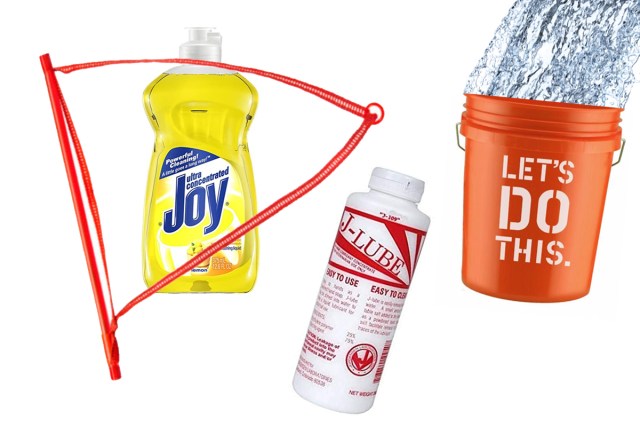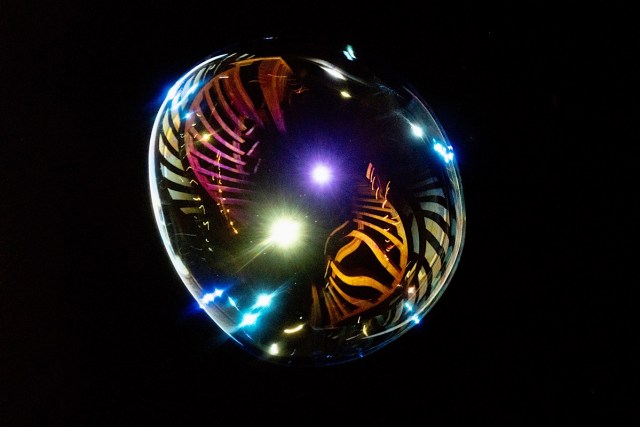From household materials, a new night sky.
The emptiness around us mirrors the emptiness within us. When I was 19, the classic Eames film Powers of Ten (9 minutes, 1977) burned this idea into my imagination. The film transports viewers, by powers of ten, to the biggest and back down to the smallest place imaginable: to outer space, then into the atom of a human skin cell.
The parts of the atom are so far apart, and the outer space so vast, that both places are totally empty.
“This lonely scene,” the narrator says from 100 million light years away, “is what most of space looks like. The richness of our own neighborhood is the exception.”

It’s nearly the end of 2020, and I’ve barely left the neighborhood since the pandemic began. I’ve kept working and stayed healthy so far, but it has been a year of hard surfaces. I don’t have a lawn, or a car to get away from it all, and the few times I’ve walked on grass or the beach have felt like another planet.
Since there is so little “nature” around to escape to, the little patch of sky behind my house has become like a refuge. Every evening, I blow giant bubbles in the courtyard, a wand in one hand and a camera in the other.

Once I’ve stepped outdoors, there’s nothing solid between me and the rest of the galaxy. Only three or four little stars manage to shine through the light pollution.

I started a project in January photographing giant bubbles during the day, using a toy wand and a homemade solution of water, veterinary lubricant, and ultra concentrated Joy.

Every day, I aimed to take a more interesting photograph than I had the day before.
At first, each bubble seemed nearly identical. But soon I became tuned in to their individuality. Each day’s weather interacted with the soap to form all different combinations of color and light.

I realized right away that my phone’s camera wasn’t good enough, and tried a newer smartphone, the iPhone 11 “Pro”, but its shutter buttons weren’t reliable. I ultimately switched to a mirrorless DSLR camera.

The weight of the strap on my shoulder and the feeling of the focus ring in my hand took me back to the manual film camera of my teenage years.
I balanced bubbles on rooftops,

encircled a bird in flight,

and lassoed the sun.

I had been blowing bubbles daily for two months when the COVID-19 quarantine began in March. As the months passed, this regular ritual helped to mark time when so much of the structure of life had disappeared.

The bubbles live only about five or ten seconds–twenty or thirty if they fly up high. This brought my mind to the opposite extreme: how ordinary rocks can be well over a billion years old. As a percentage of a rock’s existence, humans live entire lifetimes in just a few seconds. We appear to them as bubbles do to us.

After five months, I began to blow bubbles at night. The reflections from surrounding outdoor lights and the camera’s flash turned each one into a galactic scene.

It was the breakthrough I had been waiting for. It came just before summer solstice, and I began spending each long day waiting for nightfall. No matter what happened that day, I’d eventually get to visit my galaxies.



Each night I would discover something new.
A robot,

a microscopic animal,

a polished stone

and stairs to nowhere.

Animal constellations

and human forms.

Since I couldn’t see friends or family in real life, I felt an extra-strong connection to people’s comments on social media with interpretations of each shape.
My friend Sarah thought one bubble looked like a woman holding a crystal ball, and discovered that that was a popular stock photo.

“Zoom up on that one,” Brian told me one night in late August. “People need to be able to read that alien writing“.


The man-made lights reflected in these bubbles are part of the blanket of light pollution that covers the city every night, blocking our view of the real universe.
Creating these photographs has re-awakened my sense of the incredibly detailed night sky, lost to light pollution in cities and even rural areas. Each image feels like a little piece of this spirit.

Even though I started the project before the pandemic, I might not have stuck with it long enough to get to the night bubble level had it not been for the lockdown. There was nothing on the calendar to break its momentum.

Every night I take over a hundred photos, then narrow them down to a handful. Every couple of weeks, one comes out outstanding.

I imagine looking down from above, watching bubbles rise from the city block as if from a crack in the sea floor, one or two rising high enough to see the stars before popping.
There is a theory of the universe called spacetime foam, “a foamy mess of bubbles all containing mini-universes living and dying inside our own”. It’s a place where, perhaps, “our universe [is] one bubble in a frothy sea of bubble universes.”
This endless nesting makes sense. Anyone with a magnifying glass can find an intricate world watching ants, and even the biggest things on earth are tiny from space. So it wouldn’t surprise me if our whole universe was dust beneath a bed somewhere, or foam at the edge of a cosmic sea.

All photos by Emily Wick. Follow this project on Instagram at @emilywick. Prints available in my Night Bubble Print Shop.
Satellite of Love by Lou Reed.

1 thought on “Satellites of Soap”
Comments are closed.